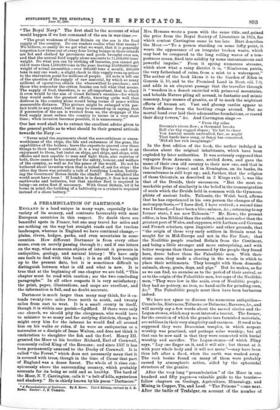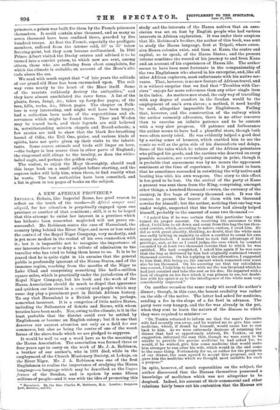A PERAMBULATION OF DARTMOOR.* ENGLAND is a land unique in
many ways, especially in the variety of its scenery, and contrasts favourably with most European countries in this respect. No doubt there are beautiful spots in France, but one may travel for miles and see nothing on the way but straight roads and flat treeless landscapes, whereas in England we have continual change,— plains, rivers, hedges, parks, and even mountains in some counties. How different Dartmoor is from every other scene, even on merely passing through it ; and if one loiters on the way, what numerous objects of interest it presents in antiquities, geology, and natural history ! We have only one fault to find with this book ; it is an old book brought up to the present date, but it is sometimes difficult to distinguish between what is old and what is new. It is true that at the beginning of one chapter we are told, " This chapter must be read with caution ; see the two concluding paragraphs." In all other respects it is very satisfactory; the print, paper, illustrations, and maps are excellent, and the information is full, and no doubt accurate.
Dartmoor is much larger than many may think, for it ex- tends twenty-two miles from north to south, and twenty miles from east to west. It is a small county in itself, though it is within one pariah—Lydford. If there were only one church, we should pity the clergyman, who would have to minister to so many and far outlying districts, though we might envy him for the interest he would find all around him on his walks or rides, if he were an antiquarian or a naturalist or a disciple of Isaac Walton, and does not think it unchristian to slaughter the fish and the fowl. Henry III. granted the Moor to his brother Richard, Earl of Cornwall, commonly called Sing of the Romans ; and since 1337 it has been permanently annexed to the Duchy of Cornwall. It is called "the Forest," which does not necessarily mean that it is covered with trees, though in the time of Caesar that part of England was a dense forest. The whole of it rises con- spicuously above the surrounding country, which probably accounts for its being so cold and so healthy. The bard of the Moor, N. T. Carrington, calls it " a belt of hills, mysterious and shadowy." He is chiefly known by his poem "Dartmoor."
• A Perambulation of Dartmoor. By & Rowe. Third Edition, reviled by J. B. Rowe. Exeter : J, B. Curamin, Mrs. Hemans wrote a poem with the same title, and gained the prize from the Royal Society of Literature in 1824, for which contest Carrington came in too late. Burt describes the Moor :—" To a person standing on some lofty point, it wears the appearance of an irregular broken waste, which may best be compared to the long rolling waves of a tem- pestuous ocean, fixed into solidity by some instantaneous and
powerful impulse." From it spring numerous streams, which show what a rainy district it is, " Nimborum patria, the very fatherland of rains, from a mist to a waterspout." The author of the book likens it to the Garden of Eden in Genesis ii. 10, and to the Promised Land in Deut. viii. 7.9, and adds in an eloquent passage that the traveller through it " wanders in a desert encircled with prima3val mountains, and beholds Nature piling all around, in fantastic and mimic masonry, huge masses of granite, as if to mock the mightiest efforts of human art. Vast and gloomy castles appear to frown defiance from the beetling crags around. But no
mortal hand ever laid their adamantine foundations, or reared their dizzy towers," &c. And Carrington sings:— "From thy sides
Devonia's rivers flow ; a thousand brooks Roll o'er thy rugged slopes ; 'tis but to cheer Von Austral meads unrivalled, fair, as aught That bards have sung, or fancy has conceived, 'Mid all her rich imaginings."
In the first edition of the book, the author indulged in theories about the original inhabitants, which have been exploded by later authorities. It was seriously supposed that voyagers from Armenia came, settled down, and gave the name of their own old country to their new one, and that in the River Ernie (Arnie) and in Ermington, on its banks, its
remembrance is still kept up ; and, further, that the religion of these Orientals, as described in 2 Binge xxiii. 5, was like
that of the Druids, their successors. " But the most re- markable point of similarity is the belief in the transmigration
of souls which the Druids held in common with the Gymnoso- phists of ancient India. Taliessin, the Welsh bard, affirms that he has experienced in his own person the changes of the metempsychosis,—' I have died, I have revived ; a second time
was I formed,—I have been a blue-salmon, &c. ; returning to my former state, I am now Taliessin.'" Mr. Rowe, the present editor, is less Biblical than the author, and more sober than the greatest poet of Wales, and supposes, with Latham and German and French scholars, upon linguistic and other grounds, that "the origin of these very early settlers in Britain must be sought for in Mid-Europe and not in the Far East; that the Neolithic people reached Britain from the Continent, and being a little stronger and more enterprising, and with better weapons than those possessed by the people they found here, drove before them the Paleolithic men. With their stone axes, they made a clearing in the woods in which to place their settlements. They brought with them domestic animals, sheep, goats, doge, and pigs." But he makes, as far as we can find, no surmise as to the period of their arrival, or
as to the origin of the Paleolithic men, but says of the Neolithic men, " They were low in the scale, even of Neolithic people ; they had no pottery, no iron, no hand-mills for grinding corn, &e The Paleolithic people must then have been barbarous indeed.
We have not space to discuss the numerous antiquities— Cromlechs, Ristvaens, Tolmens (or Dolmens). Barrows, &c., and will merely say a few words about the sacred circles and the Logan-stones, which may moat interest a tourist. The former, for the erection of which the granite tors furnished materials,
are sublime in their very simplicity and vastness. It used to be supposed they were Draconian temples, in which serpent worship was practised, and perhaps solar worship ; but all that can be now said is that they were connected with burial worship and sacrifice. The Logan-stones—of which Pliny says, "Lay one finger on it, and it will stir ; but thrust at it with your whole body and it will not move "—may have been thus left after a flood, when the earth was washed away. The rock basins found on many of them were probably caused by atmospheric action, aided by the spheroidal structure of the granite.
After the very long " perambulation " of the Moor in one hundred and fifty pages—a valuable guide to the tourist— follow chapters on Geology, Agriculture, Mineralogy, and Mining in Copper, Tin, and Lead. " The Prisons " come next. After the battle of Trafalgar, on account of the number of prisoners, a prison was built for them by the French prisoners themselves. It could contain nine thousand, and as many as seven thousand have been confined there, guarded by five hundred troops. At first the French, especially the profligate members, suffered from the intense cold, 33° to 35° below freezing-point, but they soon became acclimatised. In 1846 Prince Albert visited the Duchy estates and advised it to be turned into a convict prison, to which now are sent, among others, those who are suffering from chest complaints, for which the climate is suitable, on account of the Moor's alti- tude above the sea.
We read with much regret that "of late years the solitude of our grand old Moor has been encroached upon. The rail- way runs nearly to the heart of the Moor itself. Some of the tourists ruthlessly destroy the antiquities," and they have almost annihilated the rarer ferns. A list of the plants, ferns, fungi, &c., takes up forty-five pages ; of the tors, hills, rocks, &c., fifteen pages. The chapter on Folk- lore is very interesting, and might well have been longer, had a collection been made of the superstitions and ob- servances which might be found there. Thor and Woden may be traced back, and their legends are still believed in, notwithstanding mission chapels and Board-schools ; a few stories are told to show that the black fire-breathing hound of Odin, the Evil One, pixies, and various kinds of spirits, have not quite given up their visits to the inhabi- tants. Some scarce animals and birds still linger on here, —the badger is less scarce than in other parts of England ; the ring-ousel still clings to the locality, as does the white- tailed eagle, and perhaps the golden eagle.
The visitor, to enjoy the Moor thoroughly, should read this large book on a small subject before starting, and the copious index will help him, when there, to find readily what he wants. The best authorities have been consulted, and a list is given in ten pages of books on the subject.

















































 Previous page
Previous page